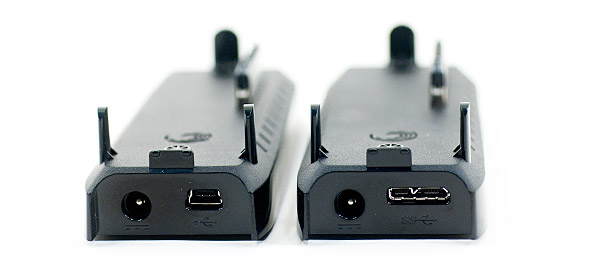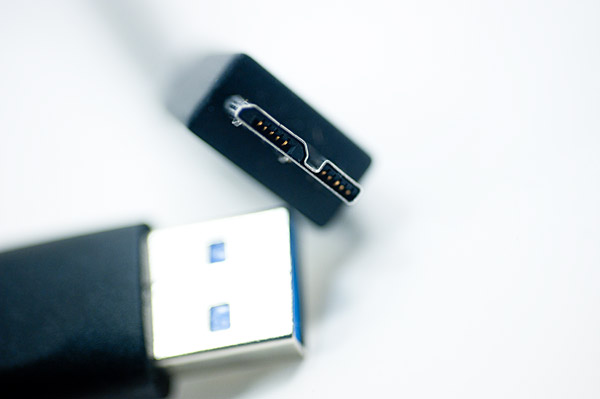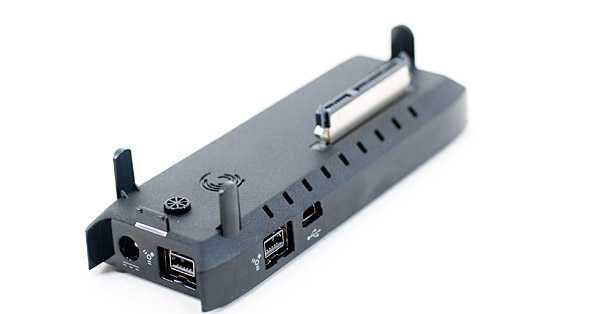The World's First 3TB HDD: Seagate GoFlex Desk 3TB Review
by Anand Lal Shimpi on August 23, 2010 12:39 AM EST- Posted in
- Storage
- Seagate
- HDDs
- GoFlex Desk
USB 2.0, 3.0 and FireWire 800 Performance
Seagate sent all three docks for review and I benchmarked the 3TB GoFlex Desk under both Windows 7 and Mac OS X 10.6.4 to get an idea for its performance. The full results are below, but I’ll give you the gist of it here.

USB 2.0 and USB 3.0 docks (left and right)
Over USB 2.0 I got around 30MB/s for sequential reads/writes. That’s 240Mbps, about half of the USB 2.0 spec maximum.
| Windows Performance Comparison | |||||
| Seagate GoFlex Desk 3TB (USB 2.0) | Seagate GoFlex Desk 3TB (USB 3.0) | ||||
| Sequential Read | 33.1 MB/s | 151.9 MB/s | |||
| Sequential Write | 26.9 MB/s | 151.2 MB/s | |||
| Random Read | 0.30 MB/s | 0.30 MB/s | |||
| Random Write | 0.93 MB/s | 0.93 MB/s | |||
USB 3.0 performance is just awesome, the drive performs just like an internal hard drive. It's a shame that USB 3.0 isn't more ubiquitous because this is great performance not to mention that you get backwards compatibility with USB 2.0 systems. The only issue is you need to make sure you don't lose the USB 3.0 cable since the drive-end of it is not backwards compatible.
I actually got better performance over USB 3.0 than I did with the drive connected via SATA at around 150MB/s for sequential reads/writes. The SATA to USB 3.0 bridge does some additional buffering that may be the cause of the improved performance here. Random performance remained unchanged regardless of what interface I used.

The USB 3.0 cable that ships with the GoFlex Desk USB 3.0 dock. It works in both USB 2.0 and USB 3.0 ports.
On the Mac, without Iometer I had to resort to XBench for the performance numbers. All of these are written via the filesystem but are uncached:
| Mac Performance Comparison - XBench 1.3 | |||||
| Seagate GoFlex Desk 3TB (USB 2.0) | Seagate GoFlex Desk 3TB (FireWire 800) | ||||
| Sequential Read | 17.0 MB/s | 74.9 MB/s | |||
| Sequential Write | 15.8 MB/s | 47.6 MB/s | |||
| Random Read | 0.68 MB/s | 0.73 MB/s | |||
| Random Write | 1.80 MB/s | 1.78 MB/s | |||
USB 2.0 performance was aroun 15 - 17MB/s while FireWire 800 managed 47.6MB/s for sequential writes and 75MB/s for sequential reads. Copying files to the drive manually I saw very similar numbers over FireWire 800 (53MB/s writes, 78MB/s reads). Note that performance was identical regardless of whether I was using Paragon’s NTFS driver or I formatted the drive in OS X’s native HFS+ file format.

FireWire 800
What this tells us is that, at least compared to FireWire 800 on a Mac Pro, the USB 3 connection in Windows is still the quickest way to write to the drive. There is one more stipulation that I must bring up. Most mainstream motherboards with an Intel chipset don’t give USB 3 controllers enough bandwidth to deliver these sorts of results. I was using a Gigabyte X58A-UD5, but many other boards dangle the USB 3 controller off of a single PCIe x1 lane running at 250MB/s (250MB/s each direction). In these cases you’ll still get better than USB 2.0 performance but you may not see the same numbers I got here.
I wrote about this issue while talking about 6Gbps SATA controllers on Intel motherboards here, but the same problem documented in that article applies to USB 3.0.










81 Comments
View All Comments
gigahertz20 - Monday, August 23, 2010 - link
The heat problem mentioned in this article makes me wonder why engineers fail to correct issues like these. It can't be that much more expensive to put a fan in the unit along with more ventilation. If it was me, I would have installed a fan inside the enclosure that would only turn on when the unit reaches a certain temperature. That way it still stays quiet, but when it gets heated up to the point where it can affect its life span, the fan will cool it down.MarkLuvsCS - Monday, August 23, 2010 - link
lol so first they have a bit of an issue with some firmware and such, but now they decide their 3TB drives should double as coffee warmers?!?!?I used to consider Seagate pretty good mfg but honestly ever since their 1TB fiasco days I don't even consider them. I certainly don't want to see less competitors out there but they really need to get their acts in order.
siuol11 - Monday, August 23, 2010 - link
I used to use Seagate exclusively... I had a RAID 0 array of 7200.10 320's, and one failed completely, erasing most of my papers and photos I'd saved from college. I also had a 500GB 7200.11, one of the few to not suffer from the .11's random fail bug- 5 months in to using it, the SATA connector snapped off (there was nothing putting pressure on it, it just snapped. I booted up my computer one morning and it couldn't find the drive). My last Seagate was a 1TB 7200.12, which started getting massive amounts of bad clusters 10 months in to using it. Thankfully it lasted long enough for me to transfer my files.Since then I've switched to Maxtor... I know you can't really use the retail drives in RAID arrays, but at least none of them have blown up on me.
Belard - Monday, August 23, 2010 - link
RAID-0 is pretty much pointless... And are more acceptable to failures.If your data was that important, then a backup drive should have been used, ESPECIALLY with a RAID-0 setup.
- MAXTOR is owned by Seagate and both "brands" come off the same assembly lines... Never heard of "Can't raid a retail drive" before. Most OEMs are single drive setups... a drive is a drive.
xded - Monday, August 23, 2010 - link
> Never heard of "Can't raid a retail drive" before. Most OEMs are single drive setups... a drive is a drive.Not entirely true. The problem is that, in case of errors, the firmware on retail drives will keep trying reading the faulty sector for too long. This delay will make the RAID controller assume that the drive is gone and it will drop it out of the chain. This unnecessarily increases the load on the array due to the subsequent rebuild phase. If then another drive should fail under the increased load, you will most likely lose the whole array, while correcting the unreadable sector in the first place would have been trivial.
This is why most manufacturers also sell "RAID edition" HDDs which, other than a tweaked firmware, also have a considerably higher MTBF.
For further information, see here http://en.wikipedia.org/wiki/Time-Limited_Error_Re...
see
Belard - Monday, August 23, 2010 - link
Oh... okay. I've not forgotten about enterprise class drives, for a REAL RAID setup, I wouldn't use consumer grade drives.But for most home users, using off the shelf is usually fine. But still RAID-0 is useless compared to the speed to todays drives. The complexity, the overheard and errors aren't worth it.
Want to improve BOOT up time and startup of your apps, spend $150~$200 for an SSD.
pcfxer - Tuesday, August 24, 2010 - link
Complexity? You must be retarded.You can geom Mirror, ZFS RAID-Z, HFS+ RAID or use the onboard software RAID.
If you know what you are doing RAID is fine, but thinking RAID will improve game load speeds is lol-eriffic.
siuol11 - Monday, October 11, 2010 - link
Man, I had completely forgotten about this comment till I came back to this thread today. Thanks for the comments guys, I'm aware of all of this. The 2 .10's in RAID 0 were 320's that I was using as data drives, I'm aware that RAID 0 on physical disks doesn't help latency.I'm fairly sure Maxtor ans Seagate have different QC mechanisms, which make all the difference in the world... And after failures of 3 successive generations of their drives, I think I'll pass. I'm still pissed that I lost all that stuff (and yes, yes, I know I should have had a backup. It just wasn't possible at that time).
Wolfpup - Thursday, September 16, 2010 - link
Yikes, this gives me yet MORE reason to avoid "RAID" 0.adamdz - Monday, August 23, 2010 - link
But you had a backup, right? So you were able to get all your papers and photos back, right?And, yeah Maxtor is owned by Seagate and it was always garbage.